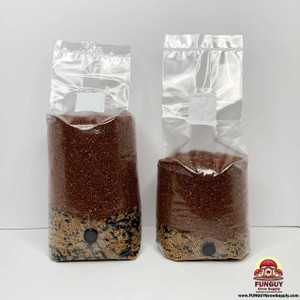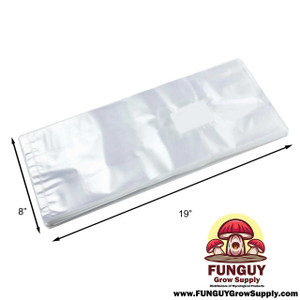Organic Sterilized Wild Bird Seed Mushroom Grain Spawn Bags
- SKU:
- WBS-3000
- UPC:
- 242424
- Product Badge:
- Best Seller
| Media | Organic Wild Bird Seed Mix |
| Colonization Speed | 2 to 4 weeks |
| Moisture content | Hydrated to a target of 50% |
| Bag dimensions | 6in H x 9in W x 6in D |
| Bag Weight/Volume | 2-4 Quarts of spawn (Approx 2-5lb each) |
Organic Sterilized Wild Bird Seed Mushroom Grain Spawn Bags
Organic Sterilized Wild Bird Seed Grain Spawn Bags Overview
Our Sterilized Wild Bird Seed (WBS) grain bags provide the perfect medium for mycelium growth, ensuring optimal conditions for mushroom cultivation. These bags are equipped with a 0.5 micron filter patch for gas exchange and a self-healing injection port, allowing for easy inoculation. To further enhance colonization, our grain bags contain a unique blend of minerals and water strengthened with gypsum and diammonium phosphate.
The grain spawn bags undergo an industrial Autoclave sterilization process, ensuring they are 100% free from contaminants and ready for inoculation. In addition, our bags maintain an ideal balance of nitrogen and nutrients throughout multiple flushes, maximizing yield potential. Witness remarkable outcomes in terms of mushroom size, quantity, and potency with these incredible bags.
Sterilized Wild Bird Seed (WBS) Grain Spawn Bag Product Details
- Grain Spawn Bags Qty (1)
- 2-4 Quarts of spawn (Approx 2-5lb each)
- Self-healing high temperature injection port
- 3mm Polypropylene bag with 0.5-micron filter patch
- Moisture content Hydrated to a target of 50%
- Organic grains - Free from herbicides and pesticides
- Optimum balance of nitrogen and nutrients
- Blend of minerals with gypsum and diammonium phosphate
- Accelerated colonization by 30% due to the grain's enhanced surface area and inoculation points
Mushroom Grain Spawn Bag Instructions
Step 1: Inoculation and Colonization
- Start by unpacking the grain spawn and removing the protective wrap.
- Gently unfold the top flap to allow fresh air to flow through the 0.5 micron filter patch.
- Sterilize the grain spawn bag and injection site with isopropyl alcohol to minimize the risk of contamination.
- Prepare your spore syringe or liquid culture solution for inoculating the sterilized grain bags with your favorite spores or mushroom strain.
- Through the self-healing injection port, simply inject around 2-4 ccs of mushroom spore or liquid culture solution into the sterile grain bag. Avoid over-saturation.
- Do not mix the spawn after inoculation. Instead, rotate it gently to distribute the solution evenly through the sterilized grain spawn portion.
- Place the inoculated bag to incubate in a warm, dark location with an incubation temperature of approximately 65-75 (18-27°C) degrees Fahrenheit.
Step 2: Fruiting Stage in a Fruiting Chamber, Monotub, or Grow Tent
- Choose your preferred fruiting method: fruiting inside the bag or transferring to another fruiting container like a terrarium, plastic tote, fruiting chamber, or monotub.
- Mix the sterilized substrate and the colonized grain into your fruiting chamber, ensuring thorough and even distribution.
- Wait for 1-2 weeks in a dark environment until the bulk substrate block is 100% colonized.
- Provide the fruiting chamber with 8-12 hours of light per day and maintain a temperature range of 70-75°F and Relative Humidity of 85-90%.
- Give the fruiting chamber at least 3-4 fresh air exchanges (FAE) daily by removing the lid and using it to fan out the old air.
- Once the mushrooms or mushroom pins start to form, increase the humidity inside the mushroom fruiting chamber to around 95-100%, by misting the chamber and its contents more frequently.
- Monitor the progress and development of the mushrooms. After 7-14 days, your substrate block will be ready for harvest.
- Carefully harvest the mushrooms or mushroom pins by twisting or cutting them at the base, ensuring minimal disturbance to the remaining mycelium.
Spawn to Bulk Ratio
- We suggest using 1 lb of colonized grain spawn for every 5 lbs of sterile substrate, whether it be manure or hardwood. Additionally, for a 3 lb injection port bag, we advise using 2.5-5ccs. (For more comprehensive information on inoculation and colonization, please refer to the section above.)
Frequently Asked Questions
How to make spawn bags?
To create a spawn bag for cultivating mushrooms, one must first prepare the substrate by using sterilized grains or sawdust as a suitable medium.
The following steps can be followed to make a spawn bag:
- Fill autoclavable filter patch bags with the prepared substrate, leaving some headspace.
- Sterilize the filled bags through pressure cooking or autoclaving as per recommended guidelines for complete sterilization.
- Allow the bags to cool down entirely in a sterile environment before proceeding further.
- Securely seal the top of the bag using an impulse sealer to maintain sterility.
- Inoculate with spores or culture syringe, and place it in a warm, dark area for incubation.
How long does it take for mycelium to grow on grain?
The duration for the mycelium to fully colonize grain in organic sterilized mushroom spawn bags can vary depending on the species, with faster-growing varieties such as oyster mushrooms taking approximately 7-10 days, while slower-growing ones like shiitake may require 10-14 days or more.
This process involves the growth of mycelium, a network of fungal threads, in the sterilized grain bags.
Creating optimal conditions and using organic materials can promote healthier and faster mycelial growth.
How long for spores to germinate on grain?
Spore germination on grain can vary based on factors such as species and environmental conditions, with an average germination time of approximately 1-2 weeks after inoculation.
Quality spores should be used to ensure successful germination on the grain. Maintaining cleanliness throughout the cultivation process is crucial to ensure optimal results. Monitoring mycelium growth is crucial to track the progress of mushroom cultivation.
When to break up mycelium?
During the cultivation process, understanding when to break up mycelium is vital for achieving desired outcomes and optimal results. In the case of organic sterilized mushroom grain spawn bags, breaking up mycelium becomes relevant during the casing layer application stage. This step involves gently separating the mycelium to promote uniform fruiting. However, it is important to note that not all methods require this procedure, as species-specific requirements may vary.
Breaking up mycelium during this stage helps to distribute the mycelial network evenly throughout the casing layer, providing an ideal environment for fruiting bodies to develop. By following this practice, cultivators can ensure that their organic sterilized mushroom grain spawn bags yield consistent and successful results in mushroom production.
How long for mushrooms to fruit?
Successful fruiting of mushrooms depends on various factors such as environmental conditions and the specific species being cultivated. The use of organic sterilized mushroom grain spawn bags is a common method for initiating mushroom growth.
However, the time it takes for mushrooms to fruit can vary significantly. Fast-growing species like oyster mushrooms may begin to fruit within 2-4 weeks, while slower-growing varieties like shiitake can take 6-12 weeks or more.
Regular monitoring and proper environmental control are essential for optimizing fruiting in mushroom cultivation.
Where to get mushroom spawn?
Various sources provide mushroom spawn for cultivation, including specialty suppliers, local mushroom farms, online marketplaces, and mushroom cultivation workshops.
- Specialty suppliers: FunGuy Grow Supply and other reputable sources offer a wide range of high quality mushroom spawn.
- Local farms: Purchase spawn directly from growers at farmers' markets or local mushroom farms.
- Online marketplaces: Explore dedicated platforms for agriculture or gardening to find diverse options for mushroom spawn.
- Mushroom cultivation workshops: Attend workshops to learn about cultivation and buy spawn from instructors or organizers.
These sources provide mushroom spawn, giving you access to reliable options for your mushroom growing endeavors.
Can you grow your own shrooms?
Growing your own shrooms is a viable option for those interested in growing and harvesting various mushroom species at home or in a dedicated space.
By utilizing organic sterilized mushroom grain spawn bags, which can be obtained from reputable mushroom spawn suppliers, you can ensure the quality and success of your cultivation process.
Grain spawn serves as the starting material for growing mushrooms and provides the necessary nutrients and conditions for their growth.
How much grain spawn for monotub?
The optimal amount of grain spawn required for a successful monotub varies depending on the specific species, the size of the tub, and the desired colonization time. It is typically determined by using a spawn-to-substrate ratio of 1:4 to 1:5 by volume.
It is important to ensure that there is enough grain spawn distributed evenly throughout the substrate to promote efficient colonization and maximize yields. When using organic sterilized mushroom grain spawn bags, it is important to consider the type of grain spawn being used, such as rye grain spawn or other types of mushroom grain.
Following these guidelines will help ensure optimal results in mushroom growing.
How many ml of spores per bag?
The optimal amount of spores to use per bag can vary depending on species-specific guidelines, but it is recommended to use about 1-2 ml of spore solution for faster colonization and optimal results.
This ensures a successful and bountiful harvest when using organic sterilized mushroom grain spawn bags.
Do spawn bags need air?
Proper air exchange is essential for mushroom grain spawn bags to ensure optimal mycelial growth and minimize contamination risks.
These spawn bags should be sealed with a breathable filter or microporous tape, allowing for gas exchange. This enables the transfer of oxygen and carbon dioxide, necessary for the metabolic processes of the mycelium.
Maintaining the right balance of air within the sterile grain bags is crucial for successful mushroom cultivation.
How long does grain spawn last?
When properly stored in a cool and dark place, organic sterilized mushroom grain spawn bags can remain viable for 6 months to a year. However, the longevity of grain spawn may decline over time.
It is important to follow supplier guidelines for optimal shelf life and monitor spawn vitality. Conducting tests can also help determine the best results. Therefore, it is essential to consider these factors when considering how long mushroom grain spawn will last.
How to make grain spawn jar lids?
To fabricate lids for mushroom grain spawn jars, follow these steps:
- Thoroughly clean the jar lids
- Drill a 3/8' inch hole to facilitate gas exchange
- Affix a heat-resistant filter patch using either silicone adhesive or a sealant that can withstand high temperatures to the top of the mason jar lid.
These homemade jar lids with filter patches allow for gas exchange and protect against contamination, ensuring the successful cultivation of sterilized mushroom grain spawn in grain bags.



















